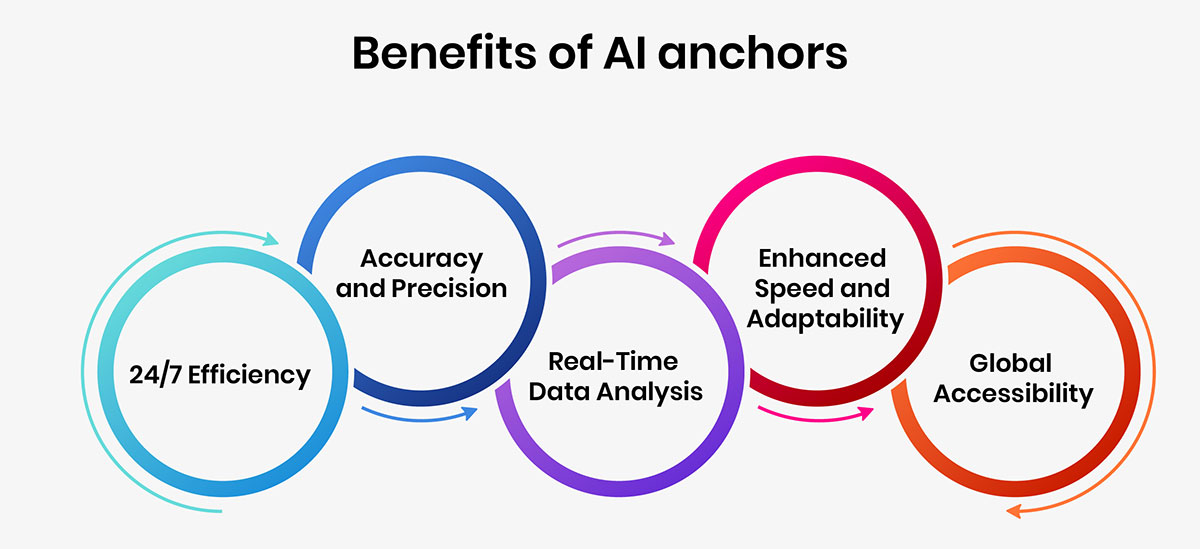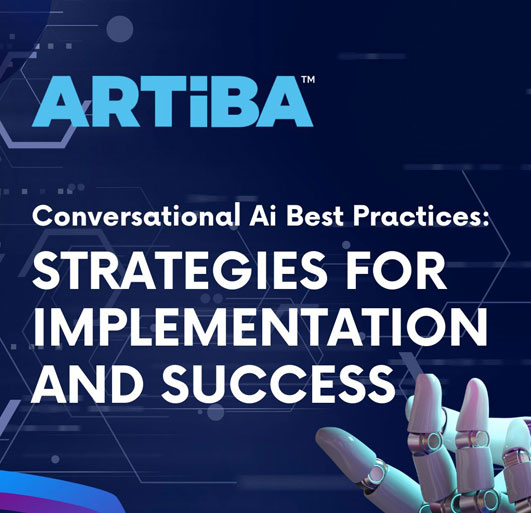How AI Anchors are Elevating Storytelling in Broadcast Journalism

The news media industry is undergoing rapid transformation driven by technological advancements. Advancements in artificial intelligence (AI) and automation are reshaping the landscape of journalism and revolutionizing newsrooms. A hybrid model combining AI technologies and human talent holds promise to both enhance efficiency and uphold quality standards in journalism.
AI is playing an increasingly important role in newsrooms, assisting journalists in content creation, fact-checking, personalized deliveries, audience engagement and more. Its potential is maximized through collaborative integration with creative human insight, flair and responsibility. Leading publications are experimenting with customized solutions tailored to their needs, resources and editorial priorities.
A balanced, symbiotic relationship between AI tools and journalists optimizes the unique strengths of both. This enables newsrooms to tackle information overload, be responsive to real-time developments and connect meaningfully with evolving audiences while preserving journalistic values and creativity. A hybrid model supporting collaborative growth fosters success in the new media landscape.
The Role of AI in Modern Newsrooms
Natural language processing (NLP) allows AI systems to analyze vast amounts of text data such as news articles, social media posts, documents and transcripts. By identifying patterns and relationships in language, NLP helps in tasks such as summarization, translation, question answering and more.
Data analytics tools utilize machine learning algorithms to detect patterns, correlations and anomalies across vast datasets from multiple sources. This aids journalists in mapping trends, generating story ideas and verifying claims. Automated content also eases repetitive reporting of routine events and statistics.
AI-empowered tools are increasingly used for multimedia analysis as well. Computer vision enables automatic extraction of insights from images, videos and visual data through optical character recognition, object detection and image description capabilities.
Together, such AI technologies are streamlining news-gathering workflows and allowing newsrooms to scale fact-checking, in-depth analysis and personalized delivery to audiences more efficiently. This frees up journalistic resources for creative, impactful storytelling.
How do AI anchors work?
AI anchors operate through a comprehensive process involving text generation, speech synthesis, facial animation and video generation.
The initial phase involves generating textual news content. This content is then transformed into lifelike speech using advanced speech synthesis technology.
Facial animation is employed to synchronize expressions like eye movements and smiles with spoken words for a more human-like delivery.
Finally, the audio and visual elements are compiled into a seamless video format presenting news in an engaging manner.
Benefits of AI anchors
The following are the benefits of AI anchors:

-
24/7 Efficiency: AI anchors can work continuously without breaks, allowing news networks to reduce operational costs significantly.
-
Accuracy and Precision: They handle repetitive tasks with unmatched accuracy and precision, minimizing the risk of errors.
-
Real-Time Data Analysis: By analyzing vast amounts of data in real-time, AI anchors can provide up-to-the-minute updates on breaking news to keep viewers informed.
-
Enhanced Speed and Adaptability: The speed and adaptability of AI anchors surpass what is possible for human anchors, ensuring timely news delivery.
-
Global Accessibility: With the ability to work round the clock, AI anchors facilitate 24/7 news coverage and make news more accessible to globally distributed audiences.
Enhancing Human Journalism with AI Tools
AI-powered tools are augmenting human journalists' capabilities instead of replacing them. For investigative stories requiring analysis of extensive documentary evidence, data mining and analytics tools aid in uncovering patterns and connecting dots missed by humans.
Real-time data insights on trending topics and emerging stories help guide journalists towards impactful angles. AI-summarized overviews of datasets assist in quickly grasping issues for well-rounded reporting. This enriches story ideas with facts and nuances improving narrative quality.
The International Consortium of Investigative Journalists' projects effectively combine automated data sifting with human judgment of results. Similarly, organizations like ProPublica have accelerated investigations leveraging data science that may have otherwise taken months with traditional research methods alone.
Such collaborations underscore AI's potential to expand journalism's scope by efficiently handling scalable data processing, allowing focus on creative storytelling and human elements difficult for machines to emulate alone such as empathy and ethics.
AI-Powered Personalization and Audience Engagement
By analyzing users’ online behaviors and preferences, AI reveals personalized news consumption patterns and interests to tailor accordingly. This boosts reader engagement through an individualized experience keeping them interested longer.
AI content recommendations based on previous interactions nudge exploration of related topics readers may like, expanding their perspectives. Tailored push notifications about breaking updates in preferred topics attract higher openings and time spent on-platform.
Personalization has also led to experiments with interactive storytelling. Consumers can now explore data visualizations, take different storyline paths based on choices and even collaborate with journalists via chatbots for guidance.
As AI gains a deeper understanding of what makes news enjoyable, shareable and discussion-worthy for individuals, it will promote quality engagement metrics like watch time, shares and membership conversions crucial to the evolving business models of publishers.
Ethical Considerations and Maintaining Journalistic Integrity
While AI brings several benefits in throughput, accuracy and consistency to journalism, it also necessitates close oversight to assure integrity. Editors play an important role in verifying AI-generated content for responsibility and adherence to facts before publication.
Transparency about any AI contribution is important for building public trust. Newsrooms' objectivity and avoidance of political, cultural or commercial biases in AI systems require stringent checks during development and use.
Periodic auditing identifies and addresses biases that may inadvertently creep in through skewed training data. Seeking diverse perspectives on ethics committees mitigates unwarranted biases. Accountability and safeguards against deliberate misuse of AI are equally crucial.
The human element of journalism centered on empathy, ethics and critical thinking remains indispensable for the profession. While AI handles routine data processing, human editors are indispensable for maintaining standards through discretion and values-driven oversight over AI workflows in newsrooms.
The Synergy Between AI and Human Creativity
Far from reducing human involvement, AI is finding synergistic collaboration with journalist talent to augment quality storytelling. Automated tools handle scalable verification and data analysis tasks, but journalists apply human judgment to crafting broader narratives around findings.
While machines excel at repetitive content production, human nuance, subjectivity and storytelling flair are irreplaceable. Hybrid teams leverage AI for increased volume and efficiency of routine reporting, deploying journalists as creative forces shaping impactful angles and visual story packages.
AI-driven multimedia editing and customization tools aid in rapid nonlinear story packaging across devices and formats. Journalists creatively pair curated visualizations, interactives and databases with written analyses enhanced by data-backed insights and perspectives.
Automated tools expanding news volumes simultaneously free up journalistic mind space for pursuing courageous, creative ventures like investigative projects requiring deep immersion difficult for AI alone currently. With human oversight maintaining integrity and editorial discretion, the synergy of man and machine unleashes innovative storytelling potential.
Training and Adapting to a Hybrid Newsroom
A collaborative future calls for multi-skilling journalists in analytical tools, data, UX design, and AI reporting techniques. Many publications now offer robust internal and external training programs equipping staff with technical skills alongside editorial and storytelling expertise.
Training ranges from crash courses and online certifications to immersive residential programs featuring industry leaders and roleplaying complex scenarios. Learning AI best practices occurs through challenges, pilots and fellowships where journalists experiment with partnering with AI startups and academics.
Furthermore, fostering a culture open to experimentation enables journalists to proactively contribute to AI development ensuring tool accuracy and suitability for tasks. Together with ongoing skill shares among newsrooms, this fosters continuous learning and adaptation for collaborating seamlessly in hybrid workflows.
Supporting life-long reskilling also cushions against disruptions from economic shifts or technological changes, empowering journalists to thrive creatively in the AI-driven future. A focus on multi-disciplinarity over any single technology equips the newsroom of tomorrow.
Examples of AI anchors
Let's explore some examples of AI anchors and how they work.
Xin Xiaomeng
One of the earliest and most well-known examples of an AI anchor is named Xin Xiaomeng. Developed by Chinese state-run media Xinhua News Agency, Xin Xiaomeng made her debut in November 2018 and has since become a regular presence presenting news bulletins.
With synthetic speech indistinguishable from a human voice, Xin Xiaomeng reads news reports on the Xinhua mobile app and website. Through highly realistic computer graphics and animation, she displays facial expressions and hand gestures that make the delivery feel natural and engaging for viewers.
Unlike human anchors, Xin Xiaomeng can work continuously without breaks and remains composed even during sensitive news topics. She demonstrates how virtual anchors can deliver 24/7 coverage at a fraction of the cost of live journalists and production crews.
Sana
Another example is Sana, India Today's AI news anchor, who recently achieved international recognition. At the prestigious International News Media Association Global Media Awards held in London, Sana captivated global audiences and won two significant awards, including first place in the category of ‘Best Use of AI in Customer-Facing Products’ for the entry titled ‘Human Collaborative AI Anchors: AI-Led Newsroom Transformation’. This recognition underscores Sana's pivotal role in enhancing newsroom operations by seamlessly integrating AI with human journalistic expertise.
Sana's success highlights a broader trend: while AI anchors bring numerous benefits, they complement rather than replace the critical and emotional depth provided by human journalists. The nuanced capabilities of human reporters—providing context, analysis, and emotional engagement—are still irreplaceable. However, AI like Sana helps bridge the gap between efficiency and depth, enabling newsrooms to operate more dynamically and responsively.
The above examples point to AI anchors advancing faster than many expected just a few years ago. As the technology progresses, virtual presenters will likely become more natural, convey more human expression and eventually surpass humans in speed, accuracy and availability. However, there are still limitations as AI lacks factors like common sense, judgment and truly understanding context.
Future Prospects and Innovations in Hybrid Journalism
The next decade will likely see further infiltration of AI throughout the news production process. Journalists will more routinely leverage conversational assistants and automated writing tools to rapidly contextualize breaking events.
Advancing natural language generation may automate routine reporting leaving journalists to focus on impactful investigative stories better fitting human abilities currently. A deeper understanding of context and nuance will improve such tools' accuracy, fairness and transparency over time.
Virtual/augmented reality promises immersive storytelling fusing visuals with interactive databases and AI narration. Journalists will shape how these platforms shape society by conveying values of empathy, credibility and responsibility.
A dynamic, AI-augmented newsroom sees human and artificial counterparts specializing respectively while collaborating seamlessly thanks to adaptive educational systems continuously multi-skilling both to tackle complex problems together.
Conclusion
AI will continue transforming yet not replacing journalism. A balanced, symbiotic integration optimizing the strengths of humans and machines delivers the highest quality news to evolving audiences. While routine processing scales, human insight, responsibility and flair for impactful storytelling remain indispensable.
Ongoing experimentation and cross-pollination between journalists, technologists and social stakeholders will define journalism's role in an AI-driven world. Progress requires not fearing change, but actively shaping it through multi-skilling, critical oversight ensuring integrity, and innovative partnerships cementing an ethically-driven future where both technology and humanity prosper together.
The hybrid newsroom model demonstrates journalism's ability to harness technological progress purposefully, responsibly, and for the benefit of societies. With conscious collaboration, boundless reporting potentials and positive societal impacts likely await.







